Karaköy
Karaköy, the modern name for ancient Galata, is a commercial quarter in the Beyoğlu district of Istanbul, Turkey, located at the northern part of the Golden Horn mouth on the European side of Bosphorus.
Karaköy | |
|---|---|
Quarter | |
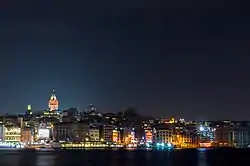 A view of the Karaköy skyline from the Bosphorus at night | |
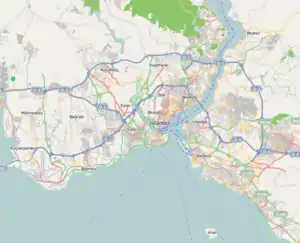 Karaköy | |
| Coordinates: 41°01′22″N 28°58′30″E | |
| Country | |
| Region | Marmara |
| Province | Istanbul |
| District | Beyoğlu |
| Time zone | UTC+2 (EET) |
| • Summer (DST) | UTC+3 (EEST) |
| Postal code | 34425 |
| Area code | 0-212 |
Karaköy is one of the oldest and most historic districts of the city, and is today an important commercial center and transport hub. The location is connected with the surrounding neighborhoods through streets originating from Karaköy Square. The Galata Bridge links Karaköy to Eminönü in the southwest, Tersane Street to Azapkapı in the west, Voyvoda Street to Şişhane in the northwest, the steeply sloping Yüksek Kaldırım Street to Beyoğlu in the north, Kemeraltı Street and Necatibey Street to Tophane in the northeast.
The commercial quarter, which was originally the meeting place for banks and insurance companies in the 19th century, is today also home to mechanical, electrical, plumbing and electronic parts suppliers.
Etymology
The word Karaköy is the combination of "Kara" and "köy". "Kara" probably originates in the Turkish word Karay, referring to a Turkic-speaking Jewish community called the Crimean Karaites. At one time, Karaites were a majority of the people who lived in this district.[1] In modern Turkish language, however, "kara" means black or dark in rural areas. "Köy" means village.
History
Karaköy has been a port area since Byzantine times when the north shore of the Golden Horn was a separate settlement, across the Golden Horn from Constantinople. After the re-conquest of the city from the Latin Empire on 1261, the emperor of Byzantium granted to the merchants of Genoa permission to settle and do business at this location as part of a defense pact.
The district developed rapidly, and the Genoese built sturdy fortifications to protect themselves and their warehouses. Fragments of the Genoese walls are still visible, but the Galata Tower, the highest and strongest point in the walls, is the most visible of all. In the 15th century, Galata looked just like an Italian city.
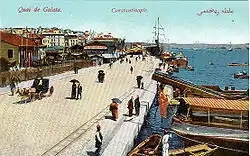
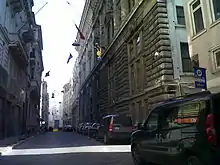
In 1455, right after the conquest of Constantinople, the district had three categories of inhabitants: temporarily sojourning Genoese, Venetian and Catalan merchants; Genoese of Ottoman citizenship; and Greeks, Armenians and Jews. The composition of the population changed in a short time, and according to a census of 1478, almost half of the district population was Muslim. From 1500 on, more Sephardic Jews settled here, who escaped from the Spanish Inquisition.
The French poet André Chénier was born at Karaköy in 1762, his father a French merchant and diplomat and his mother an Ottoman Greek.
Karaköy experienced a second wave of Christian inflow when British, French and Italian forces of the Allies came to Istanbul to fight in the Crimean War (1854–1856). The lack of piers made the unloading of troops and military equipment difficult. In 1879, a French company obtained a concession to build the quay in Karaköy, which was completed in 1895.[2]
In the last decade of the 19th century, Karaköy developed itself to a banking district. The Ottoman Bank established here its headquarters, Italian and Austrian insurance companies opened branch offices.
With the increasing trade activity in the early 20th century, the port was extended with customs buildings, passenger terminals and naval warehouses. Karaköy became also famous for its Greek taverns located along the quays.
After 1917, thousands of White Russians fleeing the Bolshevik Revolution landed here and settled in the area.
Transport
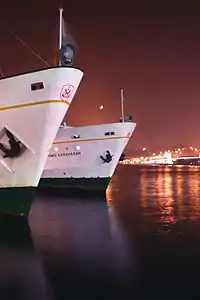
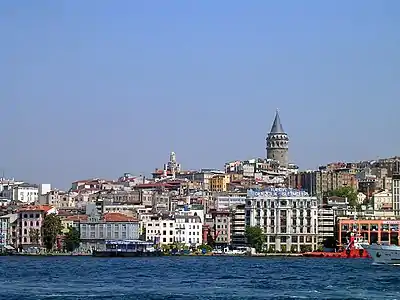
Karaköy is today a major transport hub for intercity and international passenger traffic.
The Galata Bridge connects Karaköy with the Old City, on which the fast tram line Zeytinburnu-Kabataş runs. The underground funicular, called Tünel, has been transferring people from its lower end in Karaköy upwards to İstiklal Avenue in Beyoğlu since 1876. Ferry boats run every 10 to 20 minutes from the ferry terminal on a pontoon to Haydarpaşa train terminal and Kadıköy across the Asian shore of Bosphorus.
From the Port of Karaköy, ferries operate to destinations at Black Sea such as Odessa, Yalta, Sevastopol, Kherson, Eupatoria, Novorossisk in Russia and Ukraine and Constanţa in Romania. Huge luxury cruise ships sailing to Mediterranean ports such as Athens in Greece, Dubrovnik in Croatia, Civitavecchia (Rome) and Venice in Italy berth also at the Karaköy port.[3]
Commerce
An active business center for centuries, Karaköy remains an important commercial center of Istanbul. All kinds of hardware, mechanical tools and parts are offered in Perşembe Pazarı (literally Thursday Market) around the Tersane Street. Shops selling electrical items are located in the Voyvoda Street. Various plumbing articles can be found around Kemeraltı Street. Selanik Pasajı, a shopping center right on the Karaköy Square, hosts shops specialized in electronic parts. An underground market provides also safe passage under the busy road crossing the Karaköy Square.
Karaköy is also a popular place to eat especially seafood, börek (pastry), muhallebi (Turkish pudding) and baklava. Numerous tiny fish restaurants, pubs and cafés located under the Karaköy side of the Galata Bridge roadway attract local and foreign tourists. Liman Lokantası (the Port Restaurant), situated in the passenger terminal building, is a renowned place to dine.
Istanbul's red-light district is found also in Karaköy.
Sites of interest
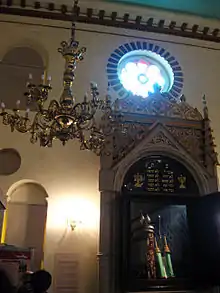
The presence of various religious and educational sites in Karaköy such as Latin Catholic, Greek Orthodox, Armenian and Bulgarian churches, Jewish synagogues, and Greek, Jewish, French, Italian and Austrian schools as well reflect its historic cosmopolitan character.[4] A wealth of architectural monuments can be found in Karaköy, left by the European communities that thrived here during the Ottoman period.
- Galata Tower
- Camondo Stairs, donated by the wealthy Sephardic Jewish banker Abraham Camondo (1785–1873) and built in baroque style, climb the hill from the Voyvoda Street up to the fashionable 19th century neighborhoods.[5]
- Museums
- Istanbul Modern, Turkey's first and only private museum dedicated to contemporary art since 2004, is housed in the renovated old Naval Warehouse No. 4.[6]
- Ottoman Bank Museum
- Jewish Museum of Turkey
- Churches
- San Pietro and Paolo Church, a Dominican church built 1604 by the Genoese next to their old Dominican convent, and rebuilt 1841-1843 by the Swiss Italian architect Gaspare Fossati, after having been destroyed twice by fire
- Sankt Georg Church, built 1675-1677 by Franciscan priests and restored 1908 by Austrian Lazarists
- San Michele Church
- San Francesco Church
- Santa Anna Church
- Santa Maria Church
- San Domenico Church
- San Zani Church
- Surp Sarkis Church built around 1360, the oldest Armenian church in Istanbul
- Surp Hisus Pırgiç Church, an Armenian Catholic church built 1834, served as the patriarchal seat from 1850 up to 1928, when the Patriarch moved to Beirut
- Surp Kirkor Lusavoric Armenian Church (1965)
- Saint Benoit Church and Monastery, a complex of church, monastery, school, hospital and orphanage built in 1427 by the Benedictines
- Galata Bulgarian Catholic Church, a small church built in early 20th century for the needs of the Catholic Bulgarian community.
- Haghios Nikolaos Turkish Orthodox Church
- Haghios Ionnis Syriac Church
- Synagogues
- Neve Shalom Synagogue (Chief Rabbinate), converted 1938 from a Jewish school building due to expansion of the community
- Tofre Begadim Synagogue (Schneider Synagogue) (used today as an art gallery)
- Italian Synagogue
- Zulfaris Synagogue, today Jewish Museum of Turkey
- Or Hodeş Synagogue, built 1897 by Georgian Jews .[4]
- Yüksek Kaldırım Ashkenazi Synagogue, built 1900 by architect Gabriel Tedeschi
- Mosques
- Arap Mosque with its square formed minaret, the oldest mosque in Istanbul converted from a church was used by Arab immigrants fleeing from the Spanish Inquisition
- Sokullu Mosque or Azap Kapi Mosque
- Yeralti Mosque (the Underground Mosque) built in the 17th century
Education
- Österreichisches St. Georgs-Kolleg Istanbul
- Deutsche Schule Istanbul (Özel Alman Lisesi) A Private school whose education is based on German
- Liceo Scientifico Italiano
- St. Benoit High School, founded 1583 by French Jesuit missionaries, is a co-educational school since 1987
- Karaköy Greek Orthodox High school
- Getronagan Armenian High School (founded in 1886)
Notable natives
- André Chénier, French poet, who is associated with the French Revolution.
References
- http://www.milliyet.com.tr/bu-savasta-600-bin-asker-oldu/ilber-ortayli/pazar/yazardetay/11.04.2010/1223372/default.htm
- Yelkenci Archived 2007-06-16 at the Wayback Machine (in Turkish)
- Let's Go Istanbul
- Jewish Sites in Galata, Istanbul, Turkey Travel Planner.
- Camondo Stairs, Galata, Istanbul, Turkey Travel Planner.
- Great Istanbul/Museums
External links
| Wikimedia Commons has media related to Karaköy. |
- Historical Galata Modern Karaköy
- Sihirli Tur (in Turkish)